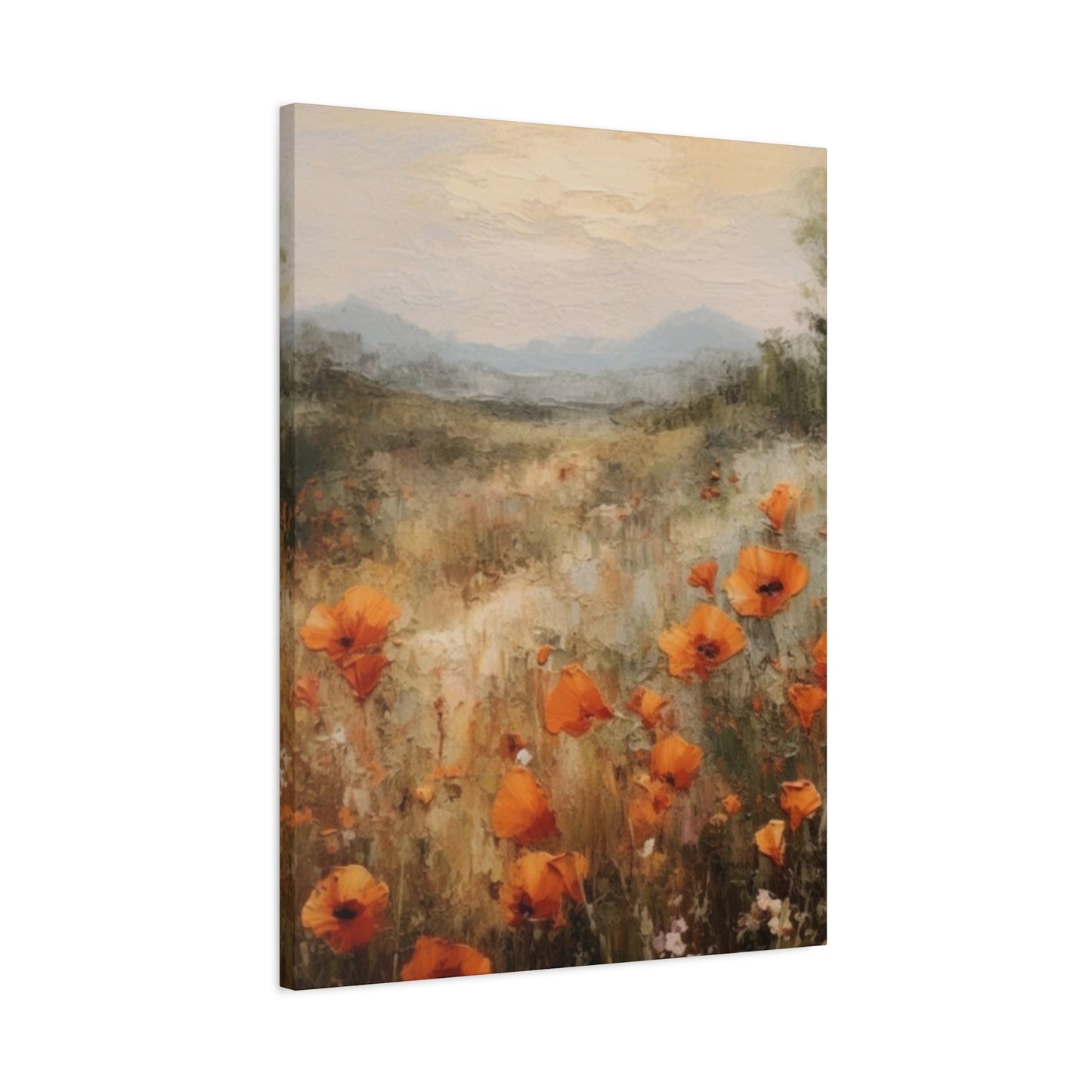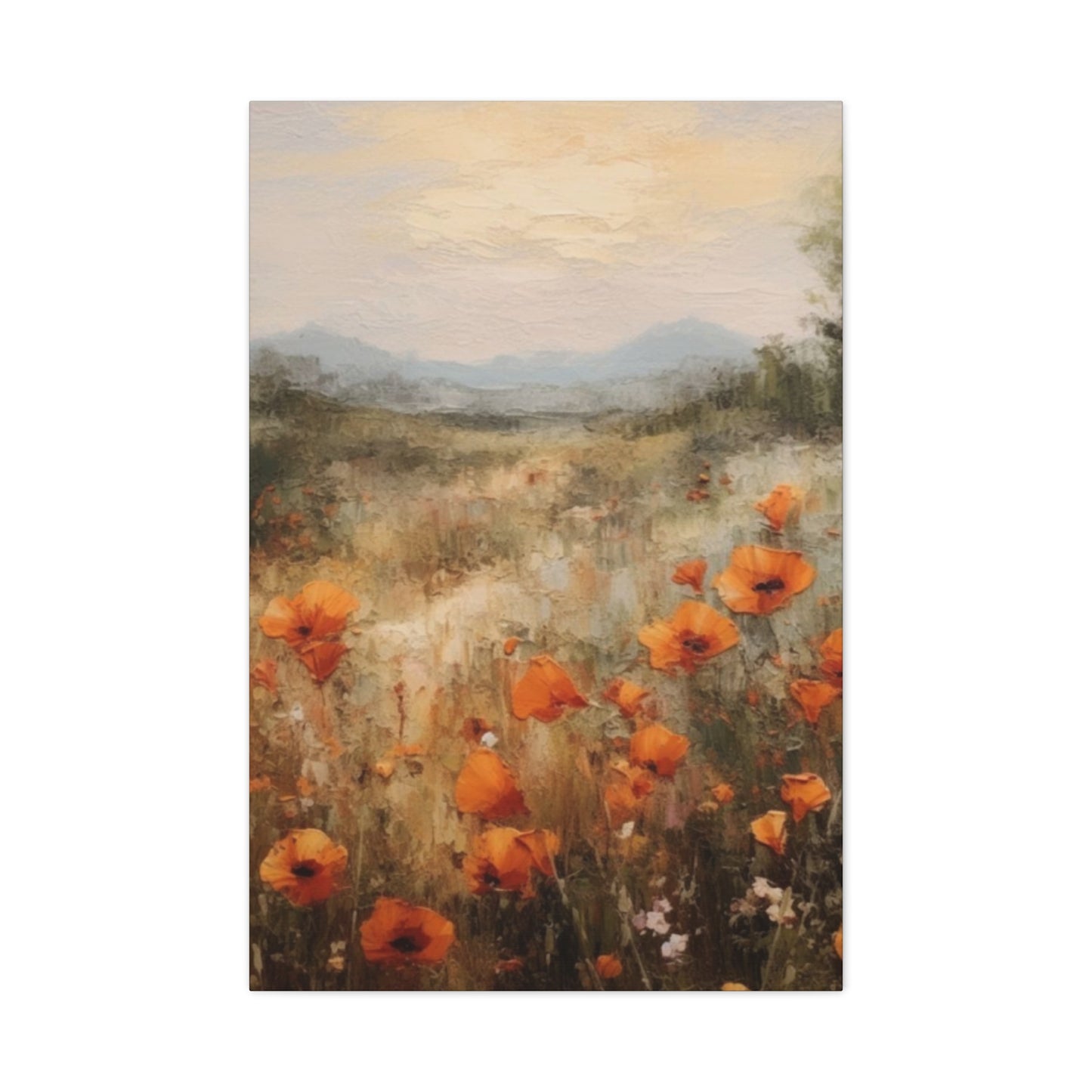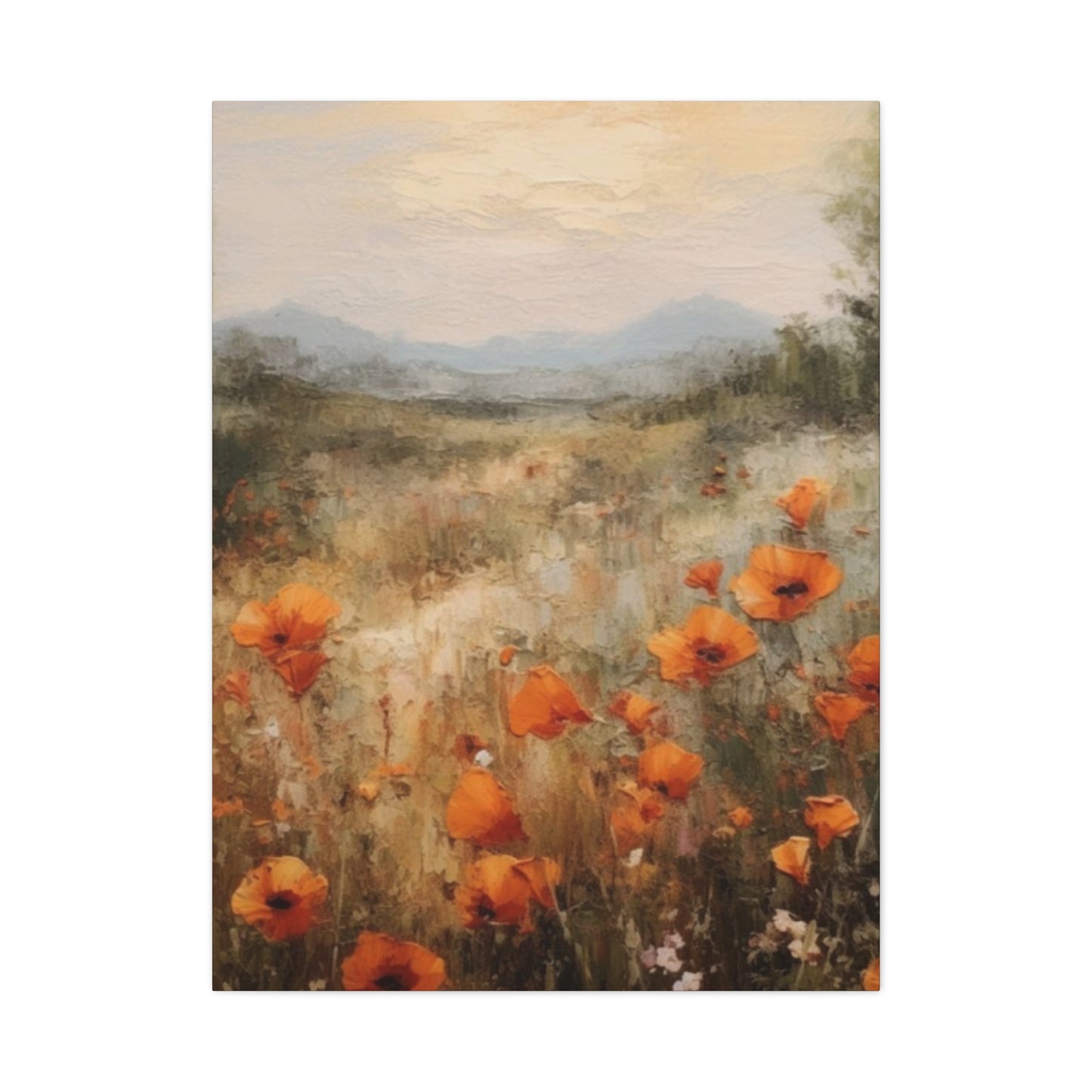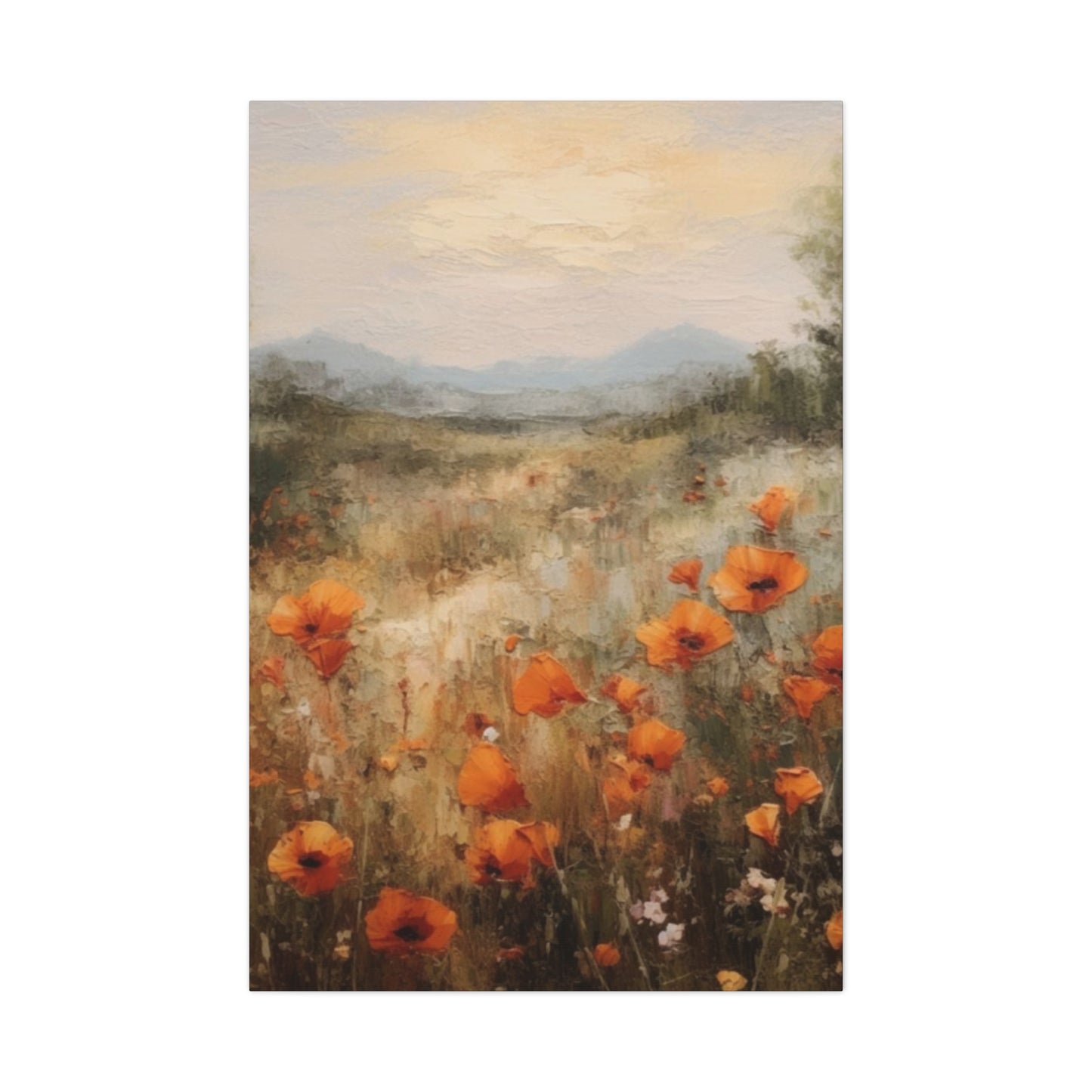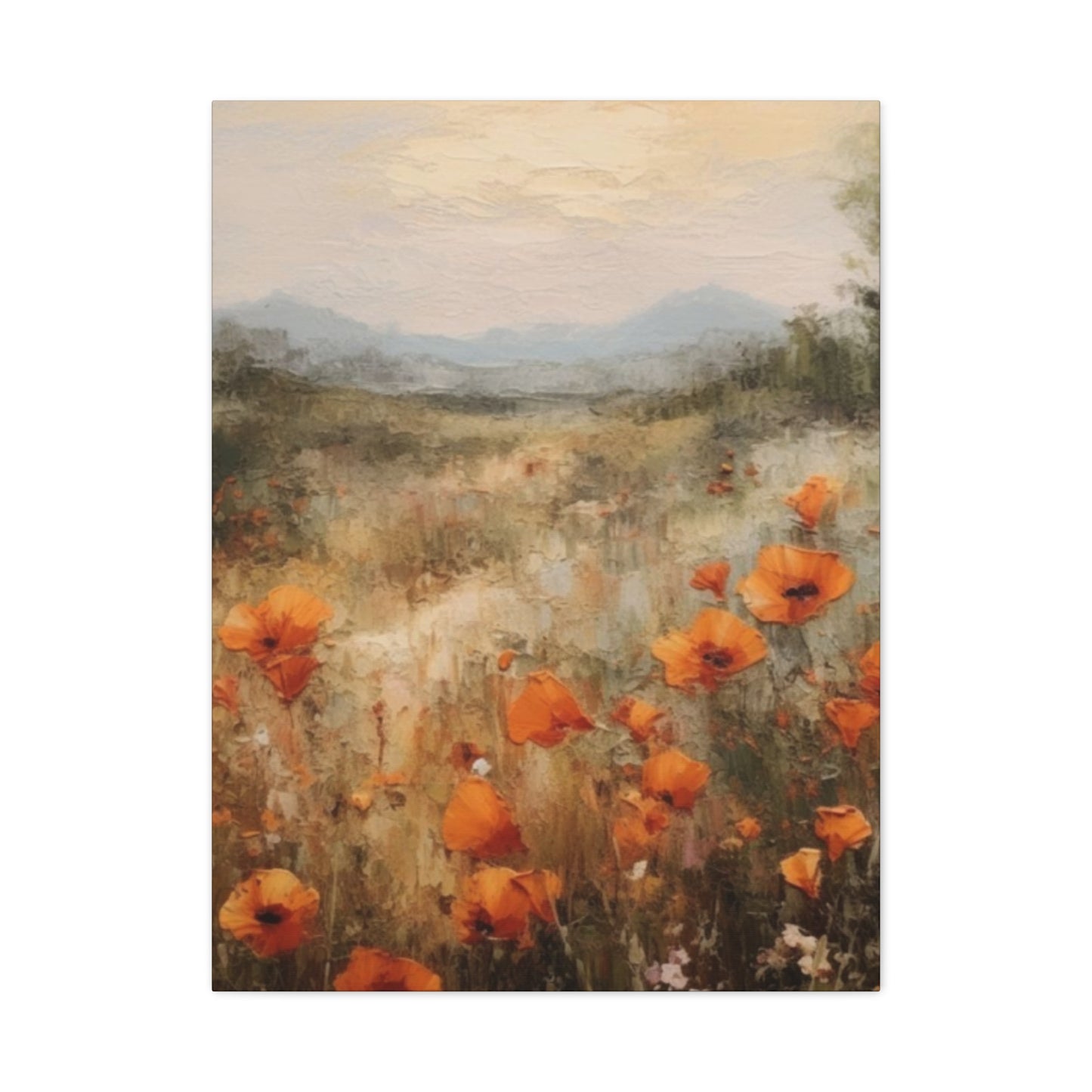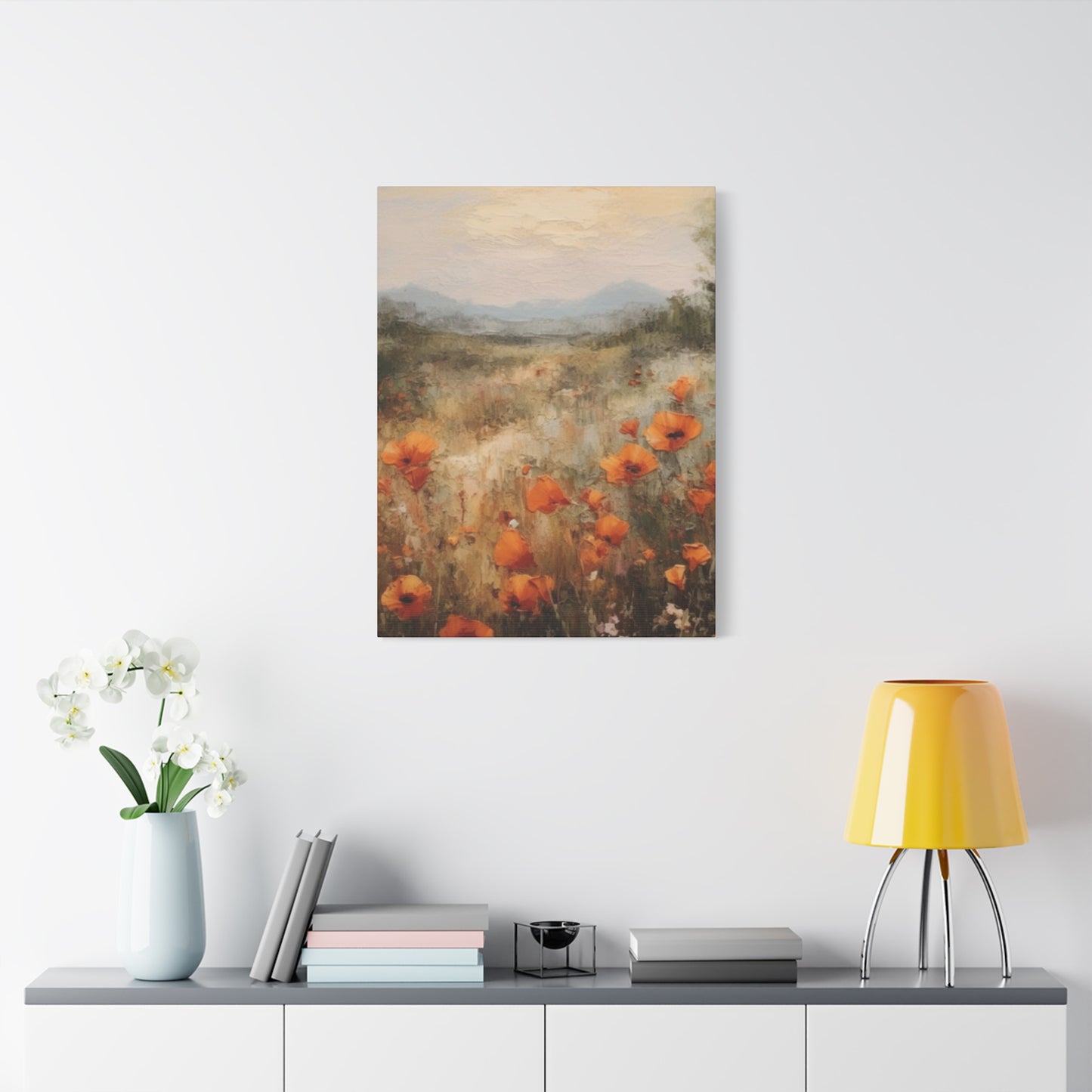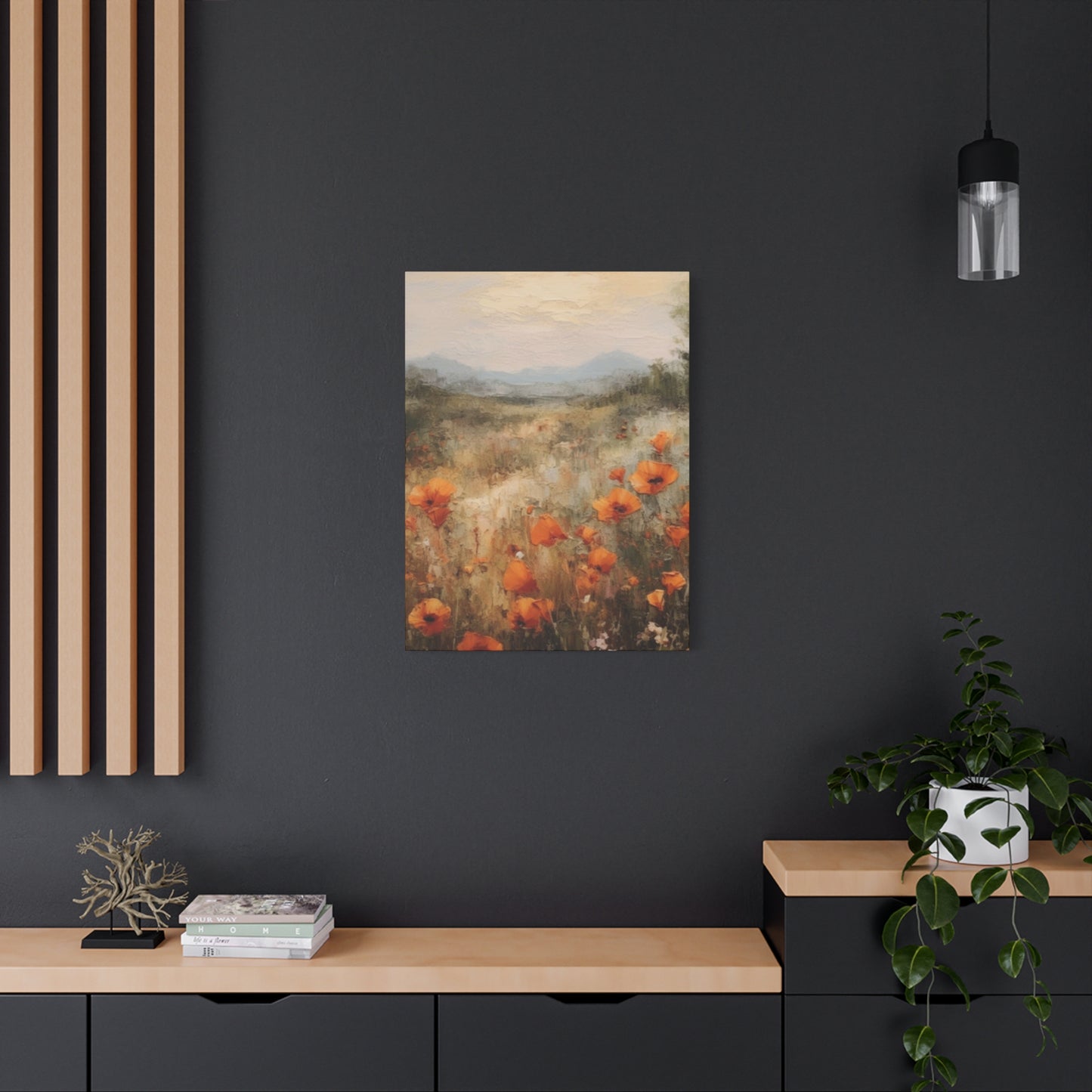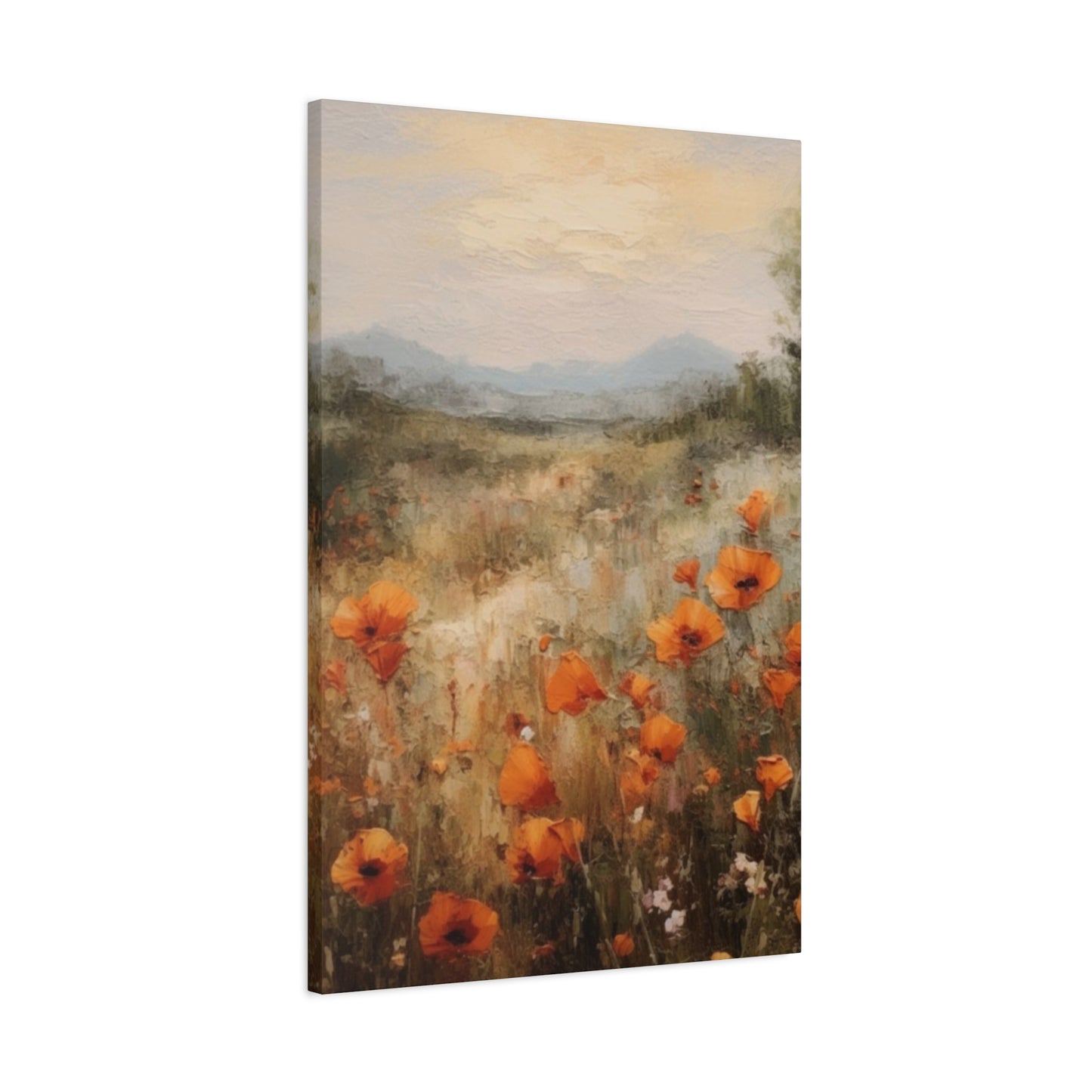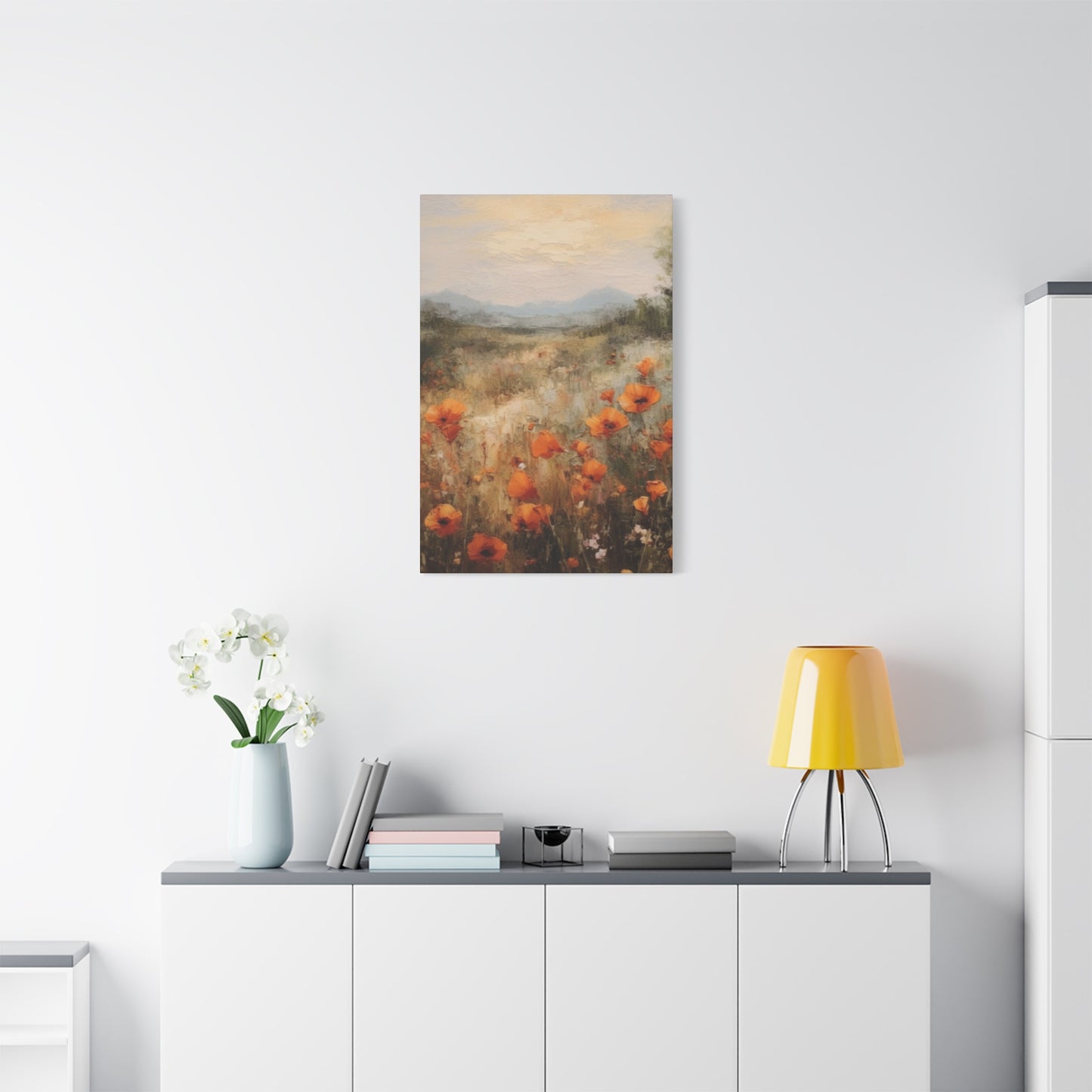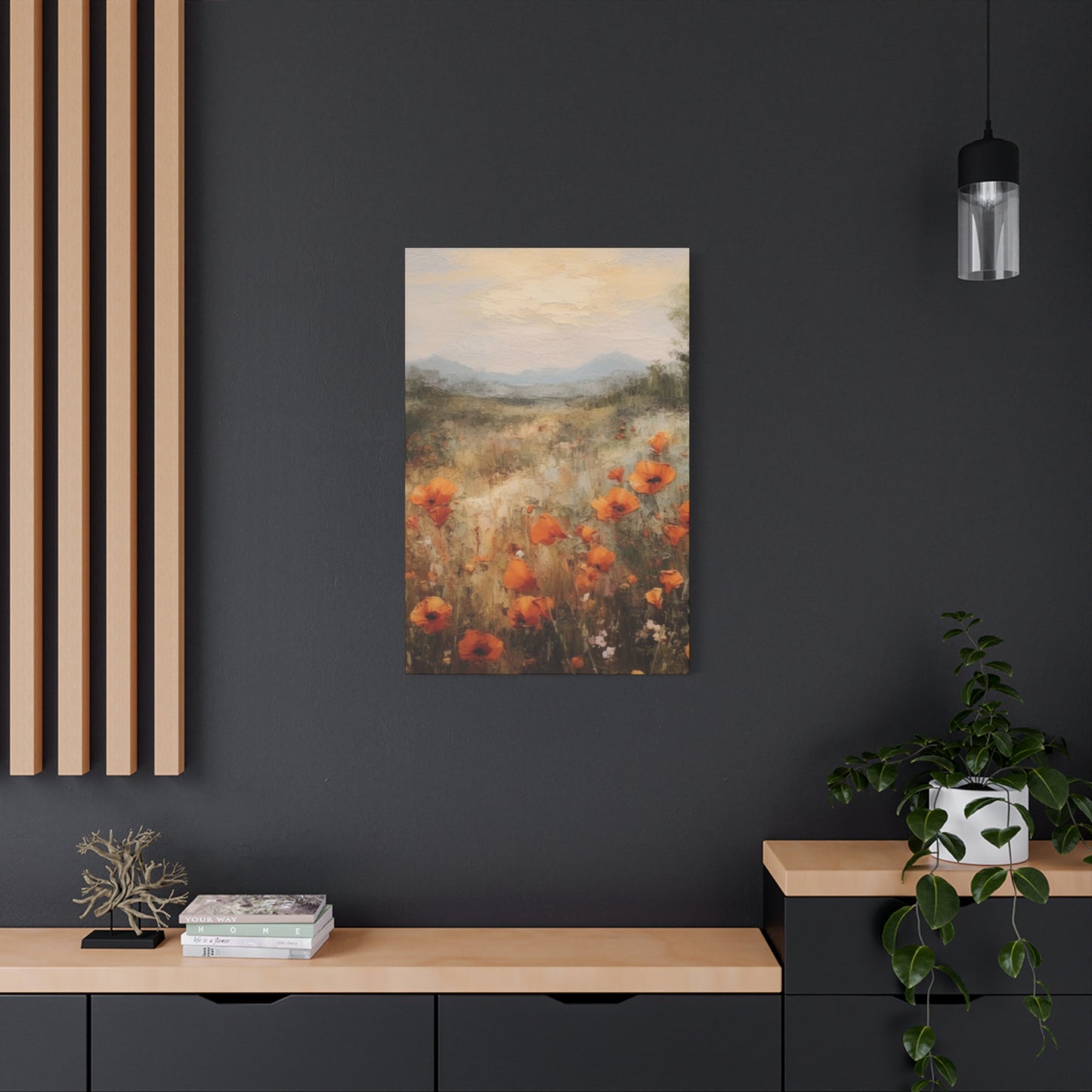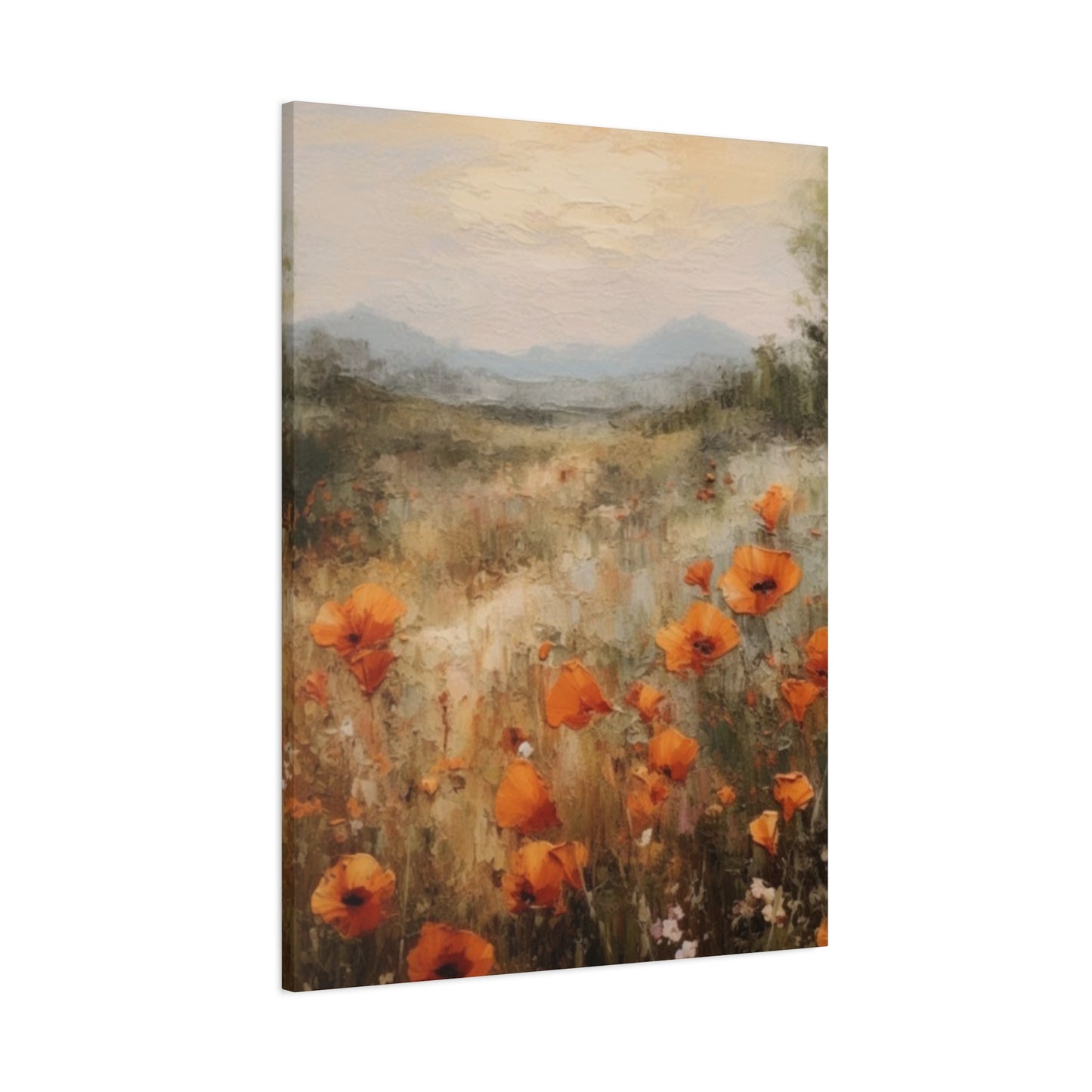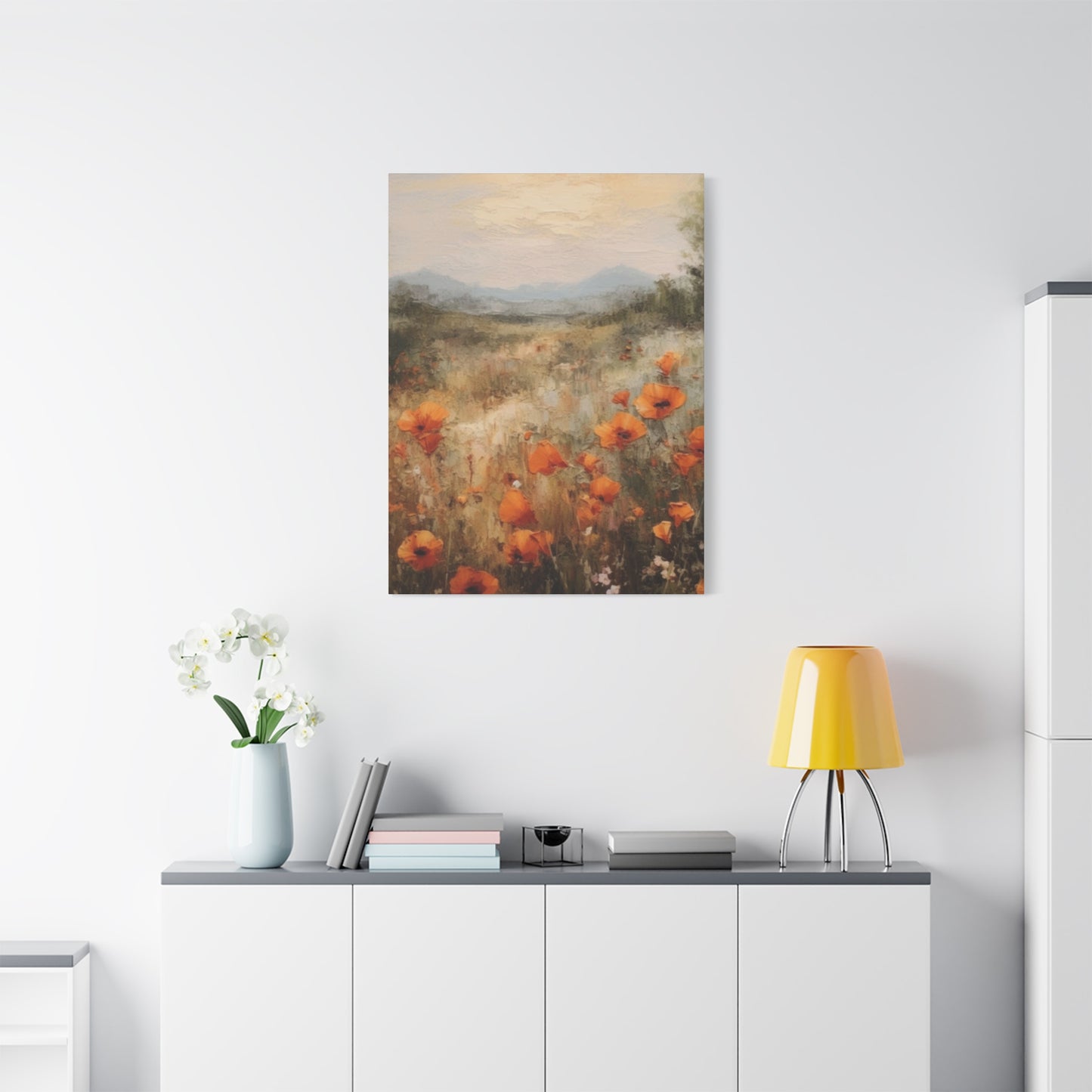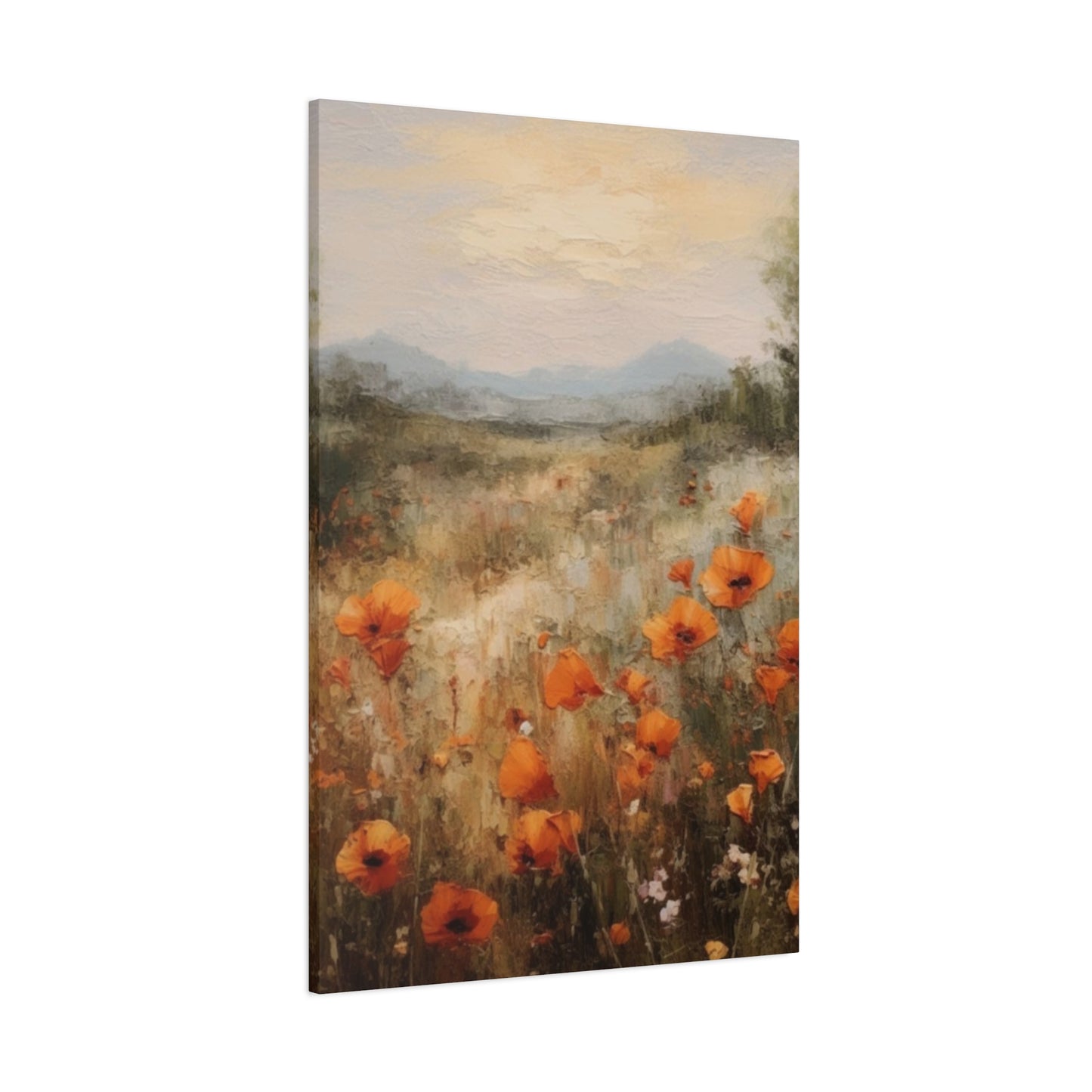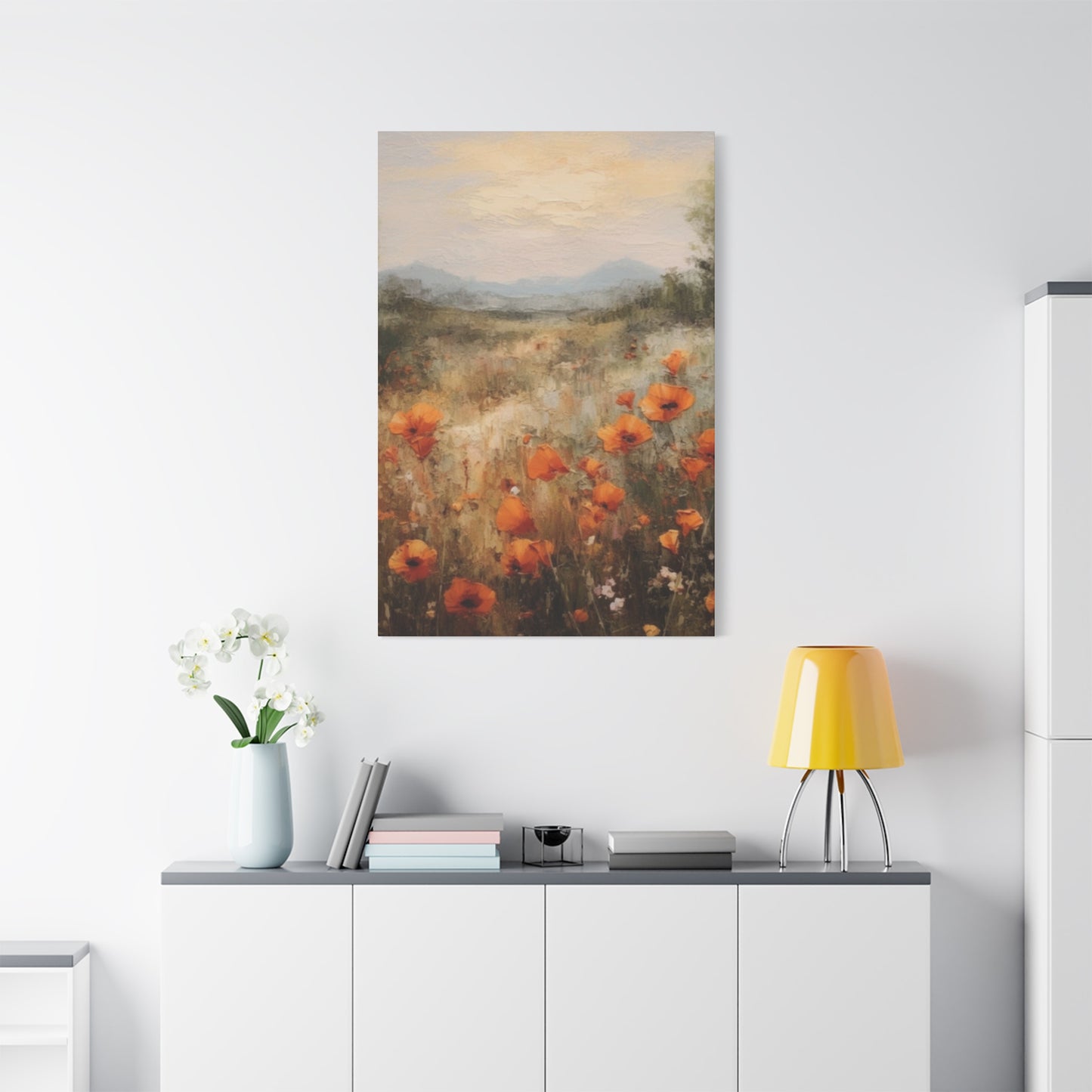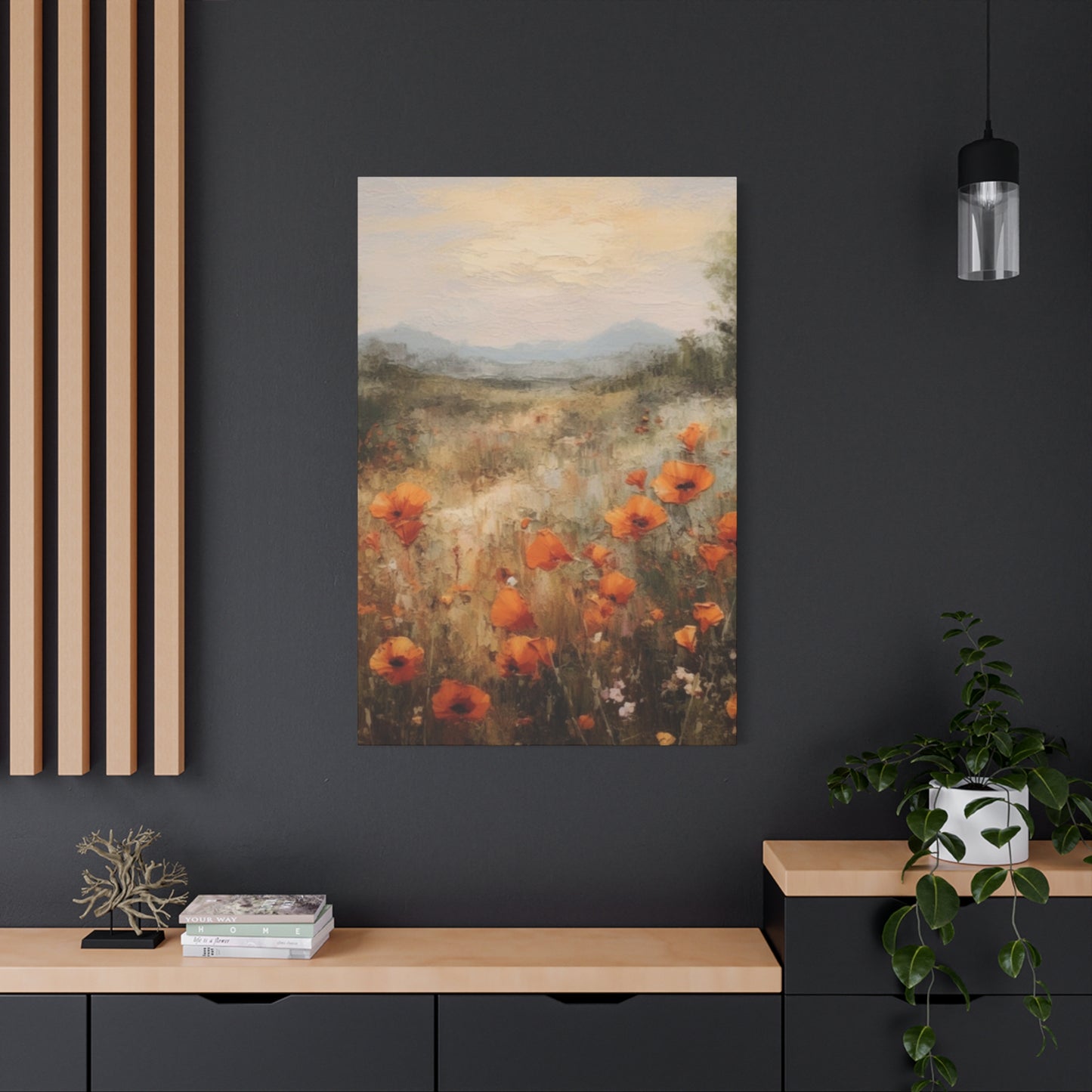Orange flower fine wall art: Elevate Your Interior Design with Vibrant Botanical Décor
Orange floral artwork brings a unique energy to interior spaces, combining warmth, creativity, and natural beauty in ways that few other design elements can achieve. This distinctive hue occupies a special place in the color spectrum, offering both the passionate intensity of red and the cheerful optimism of yellow. When translated into botanical art, orange flowers create visual focal points that transform ordinary rooms into extraordinary living environments. The versatility of orange floral pieces allows them to work seamlessly across various design styles, from contemporary minimalism to classic traditional aesthetics. Whether displayed as large canvas prints, delicate watercolors, or bold abstract interpretations, orange flower artwork has the power to influence mood, enhance natural light, and create cohesive design narratives throughout your home. Understanding how to select, style, and position these pieces can dramatically improve your interior atmosphere while expressing your personal taste and creative vision.
Enhance Living Areas with Orange Botanical Artwork
Creating inviting living spaces requires thoughtful consideration of color, texture, and visual interest, and orange botanical artwork serves as an exceptional tool for achieving these goals. Living rooms benefit tremendously from the warm, welcoming energy that orange flower pieces introduce, establishing an atmosphere that encourages conversation and relaxation. The psychological impact of orange hues includes feelings of enthusiasm, creativity, and social connection, making these pieces particularly suitable for spaces where families gather and guests are entertained. When selecting orange floral art for your living area, consider the existing color palette and how the artwork will interact with furniture, textiles, and architectural features.
A large canvas featuring vibrant orange blooms can serve as the room's centerpiece, anchoring the entire design scheme and providing a starting point for accessory selection. Smaller pieces can be grouped to create gallery walls that tell visual stories while maintaining cohesion through their shared botanical theme and color family. The key to success lies in balancing the intensity of orange with neutral backgrounds and complementary accent colors that allow the floral elements to shine without overwhelming the space. Consider the natural light patterns in your living room throughout the day, as orange artwork interacts beautifully with both morning sunlight and evening ambient lighting, changing character and intensity as light conditions shift.
Placement height matters significantly, with eye-level positioning creating the most engaging viewing experience for seated and standing visitors alike. The style of orange floral art should reflect the overall aesthetic of your living space, whether you prefer photorealistic botanical illustrations, impressionistic interpretations, or contemporary abstract representations of flower forms. Texture also plays an important role, with canvas prints offering depth and dimension that paper prints cannot match, while framed pieces behind glass provide a refined, gallery-quality presentation. The scale of artwork should be proportional to wall space and surrounding furniture, with oversized pieces making bold statements above sofas and smaller works creating intimate moments on accent walls or flanking windows and doorways.
Premium Reproductions Showcasing Orange Botanical Subjects
The market for fine art reproductions has evolved dramatically in recent years, with advanced printing technologies allowing for museum-quality reproductions that capture every nuance of original paintings and illustrations. Orange botanical subjects benefit particularly from these technological advances, as the complexity of orange pigments requires sophisticated color matching and printing techniques to achieve accurate representation. When seeking premium reproductions featuring orange blooms, look for prints produced using giclée methods on archival-quality papers or canvas materials designed for longevity and color stability. These professional-grade reproductions maintain the vibrancy of orange hues over time, resisting the fading that can occur with lower-quality printing processes and materials.
Many contemporary artists specialize in botanical subjects, creating original works that are then reproduced in limited editions, offering art collectors the opportunity to own numbered prints with certificates of authenticity. The advantage of fine art reproductions lies in their accessibility, bringing the beauty of botanical art to a wider audience while maintaining artistic integrity and visual impact. Orange flower subjects range from classic botanical illustrations reminiscent of vintage herbarium collections to contemporary interpretations that push the boundaries of traditional floral representation. Consider the artistic style that resonates with your personal aesthetic preferences, whether you gravitate toward realistic depictions that celebrate botanical accuracy or prefer stylized interpretations that emphasize color, form, and emotional expression over literal representation.
The framing choices for fine art prints significantly impact their presentation and longevity, with acid-free matting, UV-protective glazing, and quality frames ensuring that your investment remains beautiful for generations. Museum-quality reproductions often include detailed information about the original artwork, the artist's background, and the botanical subjects depicted, adding educational value and conversation-starting potential to the decorative appeal. Collecting fine art prints featuring orange botanical subjects allows for the creation of curated galleries within your home, where related pieces dialogue with each other while maintaining individual artistic merit. The investment in premium reproductions pays dividends in daily visual pleasure, as these pieces elevate the aesthetic quality of your environment and reflect sophisticated taste and appreciation for botanical beauty.
Orange Blossom Stretched Canvas for Contemporary Interiors
Contemporary interior design emphasizes clean lines, uncluttered spaces, and carefully selected focal points that make strong visual statements without excessive ornamentation. Orange blossom stretched canvas artwork aligns perfectly with these principles, offering bold color impact and natural subject matter in formats that complement modern architectural elements and furnishing styles. Stretched canvas prints eliminate the need for traditional framing, creating a sleek, gallery-wrapped presentation where the artwork extends around the edges of the canvas, allowing for seamless integration with minimalist design schemes. This frameless format emphasizes the artwork itself, removing visual barriers between the viewer and the floral subjects while creating a contemporary aesthetic that feels fresh and current.
The texture of canvas adds a tactile dimension that flat paper prints cannot achieve, with visible weave patterns contributing to the handcrafted quality that contemporary design values. Orange flower subjects on stretched canvas work particularly well in modern homes with neutral color palettes dominated by grays, whites, and natural wood tones, providing necessary warmth and visual interest without disrupting the calm, ordered atmosphere these spaces cultivate. The size options available in stretched canvas formats range from modest pieces suitable for small accent walls to dramatic multi-panel installations that span entire wall surfaces, creating immersive botanical experiences. Triptych and multi-panel arrangements featuring orange blossoms offer opportunities for creative installations that draw the eye across architectural features and create movement within static wall surfaces.
The durability of stretched canvas makes it appropriate for high-traffic areas and spaces where lighter-weight paper-based prints might be vulnerable to damage from humidity or accidental contact. Contemporary interiors often feature open floor plans where living, dining, and kitchen areas flow together, and orange blossom canvas art can serve as visual anchors that define distinct zones within these continuous spaces. The maintenance requirements for stretched canvas prints are minimal, requiring only occasional dusting and protection from direct sunlight to maintain their appearance over many years. Contemporary design values authenticity and connection to nature, and orange flower canvas art satisfies both principles by bringing organic beauty into built environments while maintaining the clean aesthetic that defines modern living spaces.
Bordered Orange Botanical Compositions for Sophisticated Presentation
The tradition of framing artwork serves both protective and aesthetic purposes, and bordered orange botanical compositions benefit from thoughtful frame selection that enhances the art while reflecting the overall design sensibility of the space. Elegant presentation through appropriate framing elevates botanical prints from simple decoration to serious art pieces that command attention and respect. The frame selection process should consider multiple factors including the artwork's style, the room's existing design elements, and the desired visual impact of the finished piece. Traditional botanical illustrations featuring orange flowers often pair beautifully with classic wood frames in warm tones that compliment the orange pigments while providing visual grounding through substantial profiles and refined details.
Contemporary interpretations of orange floral subjects may call for sleeker frame designs in metals or simple wood profiles that allow the artwork to take center stage without competing decorative elements. The mat surrounding the artwork creates breathing room between the image and the frame, with white or cream mats offering timeless elegance while colored mats can either echo tones within the artwork or provide unexpected contrast that heightens visual interest. Double matting techniques add dimensional depth and luxury to framed pieces, with coordinating mat colors creating sophisticated layering effects that enhance the overall presentation. The glazing options for framed artwork include regular glass, non-glare glass, and UV-protective acrylic, each offering different benefits in terms of clarity, weight, and protective qualities. Conservation framing techniques employ acid-free materials throughout the assembly process, ensuring that valuable prints remain in pristine condition for future generations to enjoy.
The scale of framing should be proportional to the artwork itself, with wider frames and mats appropriate for larger pieces while more delicate profiles suit smaller botanical studies. Grouping multiple framed orange floral pieces creates opportunities for cohesive gallery wall arrangements where uniform framing establishes visual connection while the varied botanical subjects provide interest and diversity. The investment in quality framing demonstrates respect for the artwork and commitment to creating interiors that reflect attention to detail and appreciation for craftsmanship. Frame styles can bridge design periods, allowing orange botanical prints to work successfully in both traditional settings where ornate frames feel appropriate and contemporary spaces where minimal framing maintains the clean aesthetic that defines modern design.
Translucent Orange Flower Compositions for Gentle Atmospheres
Watercolor techniques bring unique qualities to floral artwork, with their translucent layers, soft edges, and delicate color transitions creating gentle, atmospheric pieces that introduce warmth without visual heaviness. Orange flower compositions executed in watercolor media offer particular appeal for interior spaces that seek to balance color interest with peaceful, relaxing ambiance. The inherent qualities of watercolor painting include luminosity created by white paper showing through transparent pigment layers, giving orange hues a glowing quality that feels both present and ethereal. This medium excels at capturing the delicate structures of flower petals, with wet-into-wet techniques creating organic color blending that mirrors the natural color variations found in living blooms.
Interior spaces designed for relaxation and contemplation benefit from the quiet beauty of watercolor botanical art, where the softness of execution creates visual interest without demanding constant attention or creating restless energy. Bedrooms particularly suit watercolor orange flower pieces, as their gentle presence supports the calm atmosphere essential for restful sleep while adding personality and warmth that prevents the space from feeling clinical or impersonal. The color palette in watercolor botanical paintings often extends beyond the orange blooms themselves to include subtle greens, soft browns, and delicate background washes that create context and depth without competing with the floral focal points. Collecting watercolor botanical art supports living artists while acquiring pieces with inherent value derived from their unique, hand-created nature, as each watercolor painting represents hours of skilled work that cannot be exactly replicated.
Reproductions of watercolor paintings capture much of the original's beauty while making the artwork accessible at various price points, allowing more people to enjoy these gentle, atmospheric pieces in their homes. The styling of watercolor orange flower art benefits from simple, understated framing that respects the delicate nature of the medium, with thin profiles and generous matting allowing the artwork to breathe and maintaining its light, airy quality. Multiple watercolor pieces featuring different orange flower varieties can be grouped to create botanical collections that celebrate the diversity of orange-hued blooms while maintaining cohesion through shared medium and artistic approach. The seasonal nature of flowers makes watercolor botanical art particularly meaningful, as these pieces preserve fleeting beauty in permanent form, allowing you to enjoy orange blooms year-round regardless of garden cycles and weather conditions.
Dramatic Orange Flower Details in Premium Wall Décor
The bold presentation of orange flower petals in fine wall art creates dramatic focal points that command attention and establish strong visual hierarchies within interior spaces. This approach emphasizes the inherent beauty of individual flower structures, celebrating the curves, colors, and details that make each bloom unique while creating artwork with significant presence and impact. Close-up perspectives that fill the frame with orange petals create intimate connections between viewers and botanical subjects, inviting contemplation of forms and colors that might go unnoticed when viewing flowers from typical distances. The photographic approach to capturing orange flower details produces strikingly realistic images where every vein, texture variation, and color gradient becomes visible and important, creating artwork that appeals to both aesthetic and scientific interest in botanical subjects.
Fine wall art featuring bold orange petals works exceptionally well in spaces that embrace maximalist design principles, where rich colors, strong patterns, and confident decorative choices create interiors full of personality and visual excitement. The scale of these dramatic presentations matters significantly, with large formats allowing viewers to become immersed in the beauty of orange petals while smaller works might diminish the impact that makes this approach effective. Contemporary digital photography and printing technologies capture and reproduce the intensity of orange pigments with unprecedented accuracy, ensuring that printed artwork maintains the vibrant character of fresh blooms. The artistic choices involved in creating bold orange petal artwork include decisions about lighting, composition, depth of field, and color saturation, with each variable contributing to the finished piece's mood and visual impact.
Pairing dramatic orange flower art with carefully selected complementary pieces creates dynamic gallery walls where the bold botanical subjects anchor the arrangement while supporting pieces in coordinating colors and related themes build out the complete visual story. The placement of powerful orange petal artwork requires consideration of viewing distances and surrounding elements, as these commanding pieces need adequate space to breathe and avoid visual competition from nearby decorative objects or busy patterns in textiles and finishes. Interior spaces with substantial wall heights particularly benefit from oversized orange petal art that fills vertical space proportionally and creates the upward visual movement that makes rooms feel more spacious and architecturally interesting. The emotional impact of bold orange flower presentations includes feelings of energy, warmth, and optimism, making these pieces appropriate for spaces where you want to encourage positive moods and active engagement rather than quiet contemplation or relaxation.
Non-Representational Orange Botanical Designs for Modern Statements
Abstract interpretations of floral subjects offer exciting possibilities for interior design, combining the familiar appeal of flower themes with contemporary artistic approaches that emphasize color, form, and emotional expression over literal botanical accuracy. Orange floral prints executed in abstract styles create statement walls that anchor modern interior schemes while introducing organic inspiration in visually unexpected ways. The freedom inherent in abstract art allows artists to explore the essence of orange flowers rather than their precise appearance, distilling botanical subjects to their most fundamental visual qualities including color relationships, directional movement, and rhythmic patterns. These non-representational approaches to orange floral subjects appeal to viewers who appreciate both nature and contemporary art, providing pieces that satisfy multiple aesthetic interests simultaneously.
Statement walls require artwork with sufficient visual strength to hold attention and establish clear design intent, and abstract orange floral prints deliver this impact through bold color application, dynamic compositions, and scale that commands the space. The interpretation of abstract floral art remains open and personal, allowing each viewer to connect with the work in individual ways based on their experiences, emotions, and aesthetic preferences rather than being limited to recognition of specific flower varieties. Contemporary interiors often feature neutral backgrounds and minimal ornamentation, creating ideal contexts for abstract orange floral art to serve as primary sources of color and visual interest. The relationship between abstract art and interior design has strengthened in recent decades, with designers recognizing that non-representational works often integrate more successfully across varied design styles than realistic imagery that may conflict with particular aesthetic approaches.
Collecting abstract orange floral prints supports contemporary artists working in diverse media including digital creation, mixed media, painting, and experimental printmaking techniques that push boundaries of traditional botanical art. The emotional resonance of abstract floral work often exceeds that of realistic representations, as the emphasis on color, gesture, and composition creates visceral responses that bypass intellectual interpretation and connect directly with viewers' feelings. Installing abstract orange floral art on statement walls requires attention to scale relationships, ensuring that the artwork proportionally fills the designated space without appearing lost on expansive surfaces or cramped on smaller walls. The flexibility of abstract floral subjects allows them to work successfully in various rooms throughout the home, from living areas where they create conversation and energy to private spaces where their color and movement provide personal inspiration and aesthetic pleasure.
Incorporating Orange Botanical Prints in Streamlined Interiors
Minimalist design philosophy emphasizes intentional selection of every element within a space, with each object serving clear functional or aesthetic purposes while contributing to an overall sense of calm, order, and visual clarity. Orange flower art brings natural beauty and essential warmth to minimalist interiors without violating the principles of restraint and simplicity that define this design approach. The key to successfully integrating botanical prints in streamlined environments lies in careful editing, ensuring that the chosen artwork truly enhances the space rather than cluttering it or creating visual noise. Single statement pieces featuring orange flowers work more effectively in minimalist settings than multiple smaller works that can fragment the visual field and introduce complexity that conflicts with minimalist goals. The subject matter of orange flower art aligns naturally with minimalist values, as botanical subjects represent nature's essential beauty without artificial embellishment or unnecessary decoration.
Color selection becomes crucial in minimalist applications, with the orange tones in floral artwork needing to harmonize with the limited palette typical of these spaces while providing sufficient contrast to maintain visual interest. The mounting and presentation of orange flower art in minimalist interiors should reflect the overall aesthetic through simple framing or frameless canvas presentations that allow the botanical subject to stand alone without distracting decorative elements. Negative space plays an important role in minimalist design, and orange flower artwork should be positioned with generous clearance from edges, furniture, and other wall elements, creating breathing room that emphasizes the intentionality of the placement.
The scale of artwork in minimalist spaces often leans toward larger formats that make confident statements rather than tentative gestures, with oversized orange flower prints providing impact through size and presence rather than through quantity or decorative complexity. Lighting design enhances the effectiveness of orange flower art in minimalist environments, with directed illumination highlighting the botanical subject while maintaining the overall subdued atmosphere that characterizes these carefully controlled spaces. The maintenance of minimalist interiors requires ongoing discipline to prevent accumulation of unnecessary objects, and orange flower art pieces that earn their place in these edited environments demonstrate their value through sustained visual appeal and alignment with the space's essential character. Seasonal rotation of artwork allows minimalist spaces to evolve without abandoning core principles, with orange flower pieces perhaps featured prominently during autumn and winter months when their warmth becomes particularly welcome, then replaced with cooler botanical subjects as seasons change.
Orange Botanical Décor for Cheerful, Radiant Environments
The psychological effects of color significantly influence how we experience interior spaces, and orange hues are particularly associated with warmth, happiness, energy, and optimism. Orange flower art amplifies these positive associations by combining the beneficial psychological impacts of both color and nature imagery. Rooms designed to promote cheerful, sunny moods benefit tremendously from orange botanical pieces that reinforce the desired emotional atmosphere through their color relationships and organic subject matter. Spaces that receive limited natural light especially gain from orange flower artwork, as the warm tones create an artificial glow that compensates for insufficient sunlight while avoiding the artificiality of purely decorative color application. The connection between nature and human wellbeing has been extensively documented, with studies consistently showing that even representations of natural elements improve mood, reduce stress, and enhance overall satisfaction with interior environments.
Orange flower art delivers these benefits while also introducing the specific emotional qualities associated with orange pigments, creating layered positive effects that exceed what either element could achieve independently. Kitchen and dining areas particularly suit orange floral themes, as the association of orange with citrus fruits, autumn harvests, and abundant garden blooms connects appropriately with food preparation and consumption spaces. Morning rooms and breakfast nooks benefit from orange flower artwork's ability to capture and reflect early sunlight, creating spaces that feel energized and optimistic at the beginning of each day. The intensity of orange tones in floral artwork can be calibrated to suit different needs, with vibrant, saturated hues creating maximum energy and impact while softer, peachy tones provide warmth with greater subtlety and restraint.
Combining orange flower art with other nature-inspired design elements including natural wood, stone materials, and living plants creates comprehensive biophilic design schemes that maximize the psychological benefits of nature connection. Personal response to color remains individual, and while orange generally creates warm, positive associations, attention to personal preferences ensures that orange flower art enhances rather than conflicts with your emotional experience of space. The longevity of orange flower artwork in creating sunny environments depends partly on quality factors including pigment stability and protective framing that prevent fading and damage, ensuring that the cheerful warmth these pieces provide continues undiminished over many years.
Optimal Placement for Orange Botanical Wall Displays
Strategic positioning of artwork maximizes its visual impact and ensures that it contributes effectively to the overall design scheme of your interior spaces. Orange floral wall pieces require thoughtful placement decisions that consider room function, architectural features, lighting conditions, and furniture arrangements. Living rooms offer numerous opportunities for orange flower artwork, with the wall above the sofa serving as the primary focal point in many seating arrangements and therefore an ideal location for a significant botanical piece. Dining rooms benefit from orange floral art positioned where diners can enjoy it during meals, either on walls facing the table or behind a buffet or sideboard where the artwork becomes part of the dining experience.
Bedroom placement considerations include the view from the bed, with artwork positioned on the wall facing the foot of the bed providing something beautiful to contemplate during quiet moments while avoiding visual stimulation directly in the primary sight line that might interfere with sleep. Home offices and creative workspaces gain inspiration and energy from orange flower artwork positioned within the worker's field of view, providing visual breaks and color stimulation that can enhance creativity and maintain positive mood during long work sessions. Entryways and foyers create first impressions for visitors, and orange floral pieces in these transitional spaces communicate warmth and welcome while setting aesthetic expectations for the rest of the home.
Hallways and corridors often suffer from being underutilized spaces that simply connect more important rooms, but orange flower art transforms these passages into galleries that make every journey through your home visually rewarding. Bathrooms increasingly feature artwork as these spaces evolve from purely functional rooms into personal sanctuaries, with orange floral prints adding warmth and natural beauty while moisture-resistant framing protects the artwork from humidity damage. Stairwell walls provide vertical display opportunities where a series of orange botanical prints can be installed in ascending or descending arrangements that complement the architectural movement of the stairs.
The height of artwork installation significantly affects viewing experience, with the general principle being that the center of the artwork should fall at average eye level, approximately sixty inches from the floor, though this guideline flexes based on ceiling height, furniture placement, and whether viewers will primarily experience the space while standing or seated. Architectural features including fireplaces, built-in shelving, and window configurations influence artwork placement by creating natural focal points and visual anchors that should be respected and enhanced rather than competed with or ignored. The relationship between artwork and furniture requires careful attention, with orange floral pieces positioned to create deliberate visual connections with sofas, beds, tables, and other major furnishings while maintaining appropriate scale relationships that prevent the art from appearing too small or overwhelming relative to the furniture below it.
Harmonizing Orange Botanical Art with Natural Color Schemes
Earth tone color palettes create naturally harmonious interior environments that connect to the colors found in nature including soil, stone, wood, and organic materials. Orange flower art integrates beautifully with earth tone schemes, as orange itself occupies a position within the warm, natural color family that includes terracotta, sienna, umber, and ochre. The combination of orange floral artwork with earthy browns creates rich, grounded interiors that feel both sophisticated and comfortable, balancing visual warmth with natural authenticity. Tan and beige backgrounds allow orange flower art to pop with increased contrast while maintaining the overall warm, neutral atmosphere that makes earth tone spaces feel calm and cohesive.
The varied shades within the earth tone spectrum provide opportunities for layered color relationships where deeper browns ground the space, mid-tone tans provide neutral backgrounds, and orange floral accents introduce highlights and focal points that prevent the palette from becoming monotonous. Natural materials commonly featured in earth tone interiors including leather, jute, linen, and unfinished wood share inherent compatibility with orange flower artwork, creating comprehensive design schemes where every element reinforces the nature-inspired aesthetic.
The psychological impact of earth tone interiors includes feelings of stability, security, and connection to nature, with orange botanical art amplifying these positive associations while introducing the additional emotional benefits of floral imagery and the specific mood-enhancing qualities of orange hues. Seasonal appropriateness makes orange flower art particularly valuable in autumn and winter when the warmth of earth tones feels most appealing and relevant, though these colors schemes can work successfully year-round in climates where outdoor conditions make warmth perpetually welcome. Accent colors beyond orange can be drawn from earth tone palettes to create complete color stories, with sage green, rust red, and golden yellow working harmoniously alongside orange floral art while maintaining the natural, organic feeling that defines these schemes.
The finish and texture of surfaces in earth tone interiors affect how orange flower art reads within the space, with matte finishes creating cohesive, non-reflective environments while occasional glossy elements in artwork glazing or decorative objects create contrast and visual interest. Lighting design in earth tone spaces should enhance the natural warmth of the palette without creating excessive yellow or orange color casts that could oversaturate orange flower artwork and make the space feel artificially colored rather than naturally warm. The sustainability values often associated with earth tone design align well with botanical artwork subjects, creating interiors that express environmental consciousness through both color choices and decorative motifs that celebrate rather than exploit natural beauty.
Scientific Illustrations Highlighting Vivid Orange Shades
The tradition of botanical illustration combines scientific documentation with artistic skill, producing detailed renderings that serve both educational and aesthetic purposes. Botanical prints featuring vibrant orange tones connect contemporary interiors to this rich heritage while celebrating the specific beauty of orange-flowered plant species. Historical botanical illustrations created during the age of exploration documented newly discovered plants from around the world, with artists producing painstakingly detailed watercolors and engravings that remain valued today for both their scientific accuracy and artistic merit. Contemporary botanical illustration continues this tradition using both traditional media and digital tools, maintaining the emphasis on precise representation while often incorporating more expressive color applications and compositional approaches than strictly scientific documentation requires.
Orange-toned botanical subjects include diverse species from tropical hibiscus and bird of paradise to temperate marigolds, poppies, and zinnias, each offering distinct forms and characteristics that make them visually interesting subjects for detailed illustration. The educational aspect of botanical prints adds depth to their decorative function, allowing homeowners to learn about plant structures, growth habits, and botanical classifications while enjoying the aesthetic beauty of the artwork. Vintage botanical prints featuring orange flowers can be sourced from antique dealers, auction houses, and specialty print sellers, offering authentic period pieces that carry historical significance alongside their visual appeal.
The presentation of botanical illustrations typically follows traditional formats with Latin nomenclature, detailed labeling of plant parts, and sometimes multiple views showing different growth stages or anatomical details, creating artwork that appeals to scientific curiosity as well as design sensibility. Gallery walls composed entirely of botanical prints create natural history museum aesthetics within residential spaces, particularly effective in studies, libraries, and spaces where intellectual pursuits and appreciation for nature intersect. The color palette of botanical illustrations featuring orange flowers often extends beyond the blooms to include detailed renderings of green foliage, brown stems and roots, and occasionally the insects and pollinators associated with the plants, creating comprehensive portraits of botanical subjects in their natural contexts.
Modern reproductions of historical botanical illustrations make these images accessible and affordable while conservation concerns about original antique prints make reproduction the more practical choice for most decorative applications. The scientific accuracy of true botanical illustration requires artists to work from actual plant specimens rather than imagination or secondary sources, ensuring that the finished artwork faithfully represents the subject and could theoretically serve identification purposes as well as decorative ones. Collecting botanical prints featuring orange tones allows for the creation of specialized galleries focused on particular color families, creating cohesive collections that explore diversity within parameters while maintaining strong visual relationships between individual pieces.
Orange Botanical Displays for Seasonal Home Styling
The changing seasons provide natural opportunities to refresh interior spaces through seasonal decorating that reflects outdoor conditions and holiday themes. Orange floral wall art serves as an excellent foundation for fall decoration schemes, with the orange tones naturally connecting to autumn foliage, harvest themes, and the warm, cozy atmosphere appropriate for cooler months. The flexibility of orange flower art allows it to anchor seasonal displays while remaining appropriate year-round, unlike explicitly themed seasonal decorations that must be stored away when their specific season ends.
Autumn decorating traditions emphasize warm colors, natural materials, and harvest abundance, all of which align perfectly with orange botanical artwork that can serve as the color and thematic starting point for comprehensive seasonal transformations. Temporary seasonal elements including decorative pumpkins, branches with colorful fall leaves, and textiles in complementary warm tones can be arranged around permanent orange flower artwork, creating layered displays that feel thoroughly seasonal while requiring only modest effort and expense. The psychology of seasonal decorating connects to human needs for variety and environmental responsiveness, with regular refreshing of interior spaces preventing visual boredom while marking the passage of time in meaningful ways.
Orange flower art maintains relevance beyond autumn by connecting to spring blooming seasons when many orange flowers naturally appear, allowing these pieces to participate in spring decorating schemes alongside or instead of the expected pastels and cool tones. Holiday decorating for autumn celebrations including Halloween and Thanksgiving benefits from orange floral artwork that provides sophisticated color without the commercial character of mass-market holiday decorations, creating celebrations that feel personal and aesthetically considered. The transition between seasons can be managed smoothly through incremental additions and subtractions of seasonal elements while orange flower artwork remains constant, providing continuity and stability through decorative changes.
Photography and documentation of seasonal displays featuring orange floral art creates personal archives of your evolving interior design, providing inspiration for future years while documenting your creative growth and changing tastes. The investment in quality orange botanical artwork pays ongoing dividends through its ability to anchor multiple seasonal looks, eliminating the need to purchase and store separate artwork for different times of year. Climate considerations affect the relevance and appeal of seasonal decorating, with regions experiencing distinct seasonal changes finding more natural connection to autumn decorating traditions than year-round warm climates where fall's arrival may be subtle or absent. The social dimension of seasonal decorating includes sharing your home with visitors during holiday gatherings, and orange floral art contributes to the welcoming, festive atmosphere while maintaining sophistication and personal style that transcends generic holiday aesthetics.
Arranging Orange Botanical Art in Curated Wall Collections
Gallery wall arrangements transform individual artworks into cohesive installations that create significant visual impact while showcasing multiple pieces that might appear less substantial in isolation. Orange flower art serves as an excellent foundation for gallery walls, with its strong color providing unity while botanical subject diversity offers variety within the collection. The planning process for successful gallery walls includes selecting pieces with shared characteristics that create visual relationships, whether through common color palettes, related subjects, similar frames, or consistent artistic styles. Orange floral themes allow for substantial variation in specific botanical subjects while maintaining color-based cohesion, creating collections that reward extended viewing as visitors discover the diversity within the unified presentation.
Physical arrangement options include grid patterns that create orderly, structured galleries suitable for traditional or modern interiors, salon-style asymmetric arrangements that feel organic and collected over time, or linear horizontal groupings that work well in spaces with limited vertical wall height. Template creation using paper cutouts matching frame dimensions allows for experimentation with arrangements before committing to nail holes, ensuring that the final installation achieves desired balance and visual flow. The spacing between frames affects how the collection reads, with closer spacing creating unified impact where the gallery wall functions as a single large element, while generous spacing maintains each piece's individuality within the larger grouping.
Orange flower art in gallery walls benefits from frame consistency that creates coherent presentation, though intentional variation in frame styles can work successfully when executed with clear design intent rather than as accidental mismatch. Background wall color significantly affects gallery wall appearance, with white or neutral backgrounds allowing orange floral art to maintain maximum vibrancy while painted accent walls in complementary colors can create dramatic contexts that intensify the overall effect. The inclusion of non-art elements including mirrors, sculptural objects, or decorative plates can add dimensional variety to gallery walls, though such mixed-media approaches require careful balance to prevent confusion or cluttered appearance.
Growth potential should be considered when planning gallery walls, with arrangements designed to accommodate future additions allowing collections to expand as you discover new orange flower art pieces that deserve inclusion. Documentation of gallery wall arrangements through photography provides reference material for recreations after moves or renovations while creating shareable content that celebrates your interior design achievements. Professional installation services can ensure perfect leveling, appropriate hanging hardware, and optimal spacing for gallery walls where the complexity of the arrangement or the value of the artwork justifies the expense. The maintenance of gallery walls includes periodic dusting, checking hanging hardware security, and ensuring that lighting remains appropriate as bulbs age and require replacement, keeping the installation looking fresh and properly cared for over many years.
Delicate Orange Hues in Decorative Botanical Paintings
The spectrum of orange includes wide variation from pale, peachy tones to deep, saturated hues approaching red-orange territory, and soft orange tones offer particular appeal for interiors seeking warmth without the intensity of vibrant orange. Fine floral paintings featuring gentle orange shades create subtle beauty that enriches spaces while maintaining calm, restful atmospheres. The lightness of soft orange tones makes them versatile across varied design styles and color schemes, working successfully with both warm and cool palettes while avoiding the potential overwhelm that saturated orange can create in small spaces or conservative design schemes.
Artistic techniques including glazing, dry brushing, and color blending allow painters to achieve the luminous, translucent quality that characterizes successful soft orange floral work. The romantic quality of gentle orange flower paintings suits bedrooms, powder rooms, and intimate seating areas where delicate beauty enhances the sense of retreat and personal sanctuary. Collecting fine floral paintings supports living artists while acquiring unique pieces that carry inherent value beyond their decorative function, with original paintings representing hours of skilled labor and creative vision. The subject selection for soft orange floral paintings often includes species with naturally pale blooms including certain roses, ranunculus, and peonies, celebrating the subtle beauty of these varieties rather than the boldness of more intensely colored flowers.
Interior color palettes built around soft orange tones create sophisticated, nuanced environments that avoid the predictability of pure neutral schemes while maintaining restraint and refinement. The framing of delicate orange floral paintings should respect their gentle character through simple profiles and soft-colored mats that enhance rather than overpower the subtle artwork. Multiple soft orange paintings grouped together create cohesive collections with quiet impact, building cumulative presence through repetition while each individual piece maintains its delicate character. Lighting design for spaces featuring soft orange floral art should provide sufficient illumination to appreciate the subtle color variations and brushwork details without harsh brightness that might wash out the delicate tones.
The seasonal appropriateness of soft orange extends beyond autumn to include spring and summer when peachy tones connect to sunrise skies, blooming fruit trees, and the gentle warmth of pleasant weather. The psychological impact of soft orange includes feelings of comfort, gentle energy, and optimistic calm, creating emotional atmospheres that balance stimulation with relaxation. The longevity of fine floral paintings depends significantly on proper care including protection from direct sunlight, climate control preventing excessive humidity or dryness, and professional conservation when needed to address any deterioration. The personal connection many people feel toward original paintings exceeds responses to prints and reproductions, making the investment in fine floral art particularly rewarding for those who value the presence of handcrafted, unique pieces in their living environments.
Oversized Orange Botanical Canvases for Visual Drama
Scale plays a crucial role in interior design, and large orange flower canvases create immediate impact through their commanding size and presence. Oversized botanical artwork transforms walls into focal points that anchor entire room designs while making bold statements about the inhabitant's confidence and aesthetic vision. The production of large canvas prints requires advanced printing equipment and careful attention to resolution, ensuring that the increased size doesn't result in pixelation or loss of detail that would compromise image quality. Spaces with high ceilings particularly benefit from large-scale artwork that fills vertical space proportionally and prevents the uncomfortable feeling of under furnished walls common in rooms with generous dimensions.
The viewing distance for large orange flower canvases should be sufficient to allow viewers to take in the complete composition, making these pieces most appropriate for spacious rooms where adequate distance naturally exists between the artwork and primary seating or standing areas. Installation of large canvas pieces requires proper mounting hardware rated for the weight of the artwork, with attention to wall construction ensuring that anchors penetrate structural elements rather than relying solely on drywall which cannot safely support heavy pieces. The cost of large canvas prints reflects the materials and production processes involved, but the investment often proves more economical than purchasing multiple smaller pieces while delivering greater impact through unified scale
Conclusion:
In conclusion, orange flower fine wall art is a powerful and stylish way to enhance your interior design with the radiant energy and organic beauty of nature. More than just a decorative element, it serves as a vibrant symbol of life, warmth, and creativity—qualities that resonate deeply in any living space. Whether displayed in a cozy living room, a serene bedroom, a cheerful kitchen, or a stylish office, orange floral prints have the unique ability to brighten a room while adding a rich layer of emotion and personality.
The vibrant orange hue itself carries psychological and emotional weight. Often associated with joy, enthusiasm, and creativity, oranges can spark positive energy and uplift the overall mood of a space. When paired with floral imagery, this dynamic color becomes even more impactful, representing growth, transformation, and natural elegance. This makes orange flower wall art especially appealing for those seeking to create an environment that feels both energizing and harmonious.
One of the greatest strengths of orange flower fine wall art lies in its versatility. These prints seamlessly blend with a variety of interior styles, from the clean lines of contemporary minimalism to the warm textures of bohemian or farmhouse design. A bold, oversized orange bloom can serve as a striking focal point, while a series of smaller prints can be curated into a cohesive gallery wall that adds depth and texture. Whether you lean toward a modern aesthetic or prefer a more traditional setting, orange floral art can be adapted to complement and enhance your vision.
Additionally, the natural subject matter of floral art carries with it a timeless appeal. While design trends come and go, botanical imagery remains a beloved staple in home décor. Orange flower prints, in particular, stand out for their ability to bring energy and emotion into a room without overwhelming the space. Their presence feels organic, refreshing, and deeply human—connecting us to the rhythms of the natural world even in the most urban environments.
Beyond aesthetics, these artworks often carry symbolic meaning. Orange flowers such as marigolds, lilies, and poppies represent emotions like passion, resilience, and new beginnings. By incorporating them into your space, you are not only elevating your interior design but also weaving subtle layers of meaning and emotion into your surroundings.Ultimately, orange flower fine wall art is more than a passing design trend—it is a timeless celebration of color, nature, and personal expression. It offers a simple yet impactful way to create vibrant, uplifting, and emotionally resonant interiors that truly reflect your style and spirit.

















